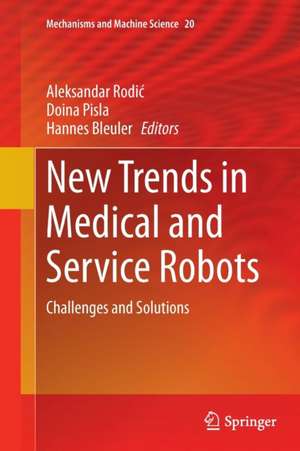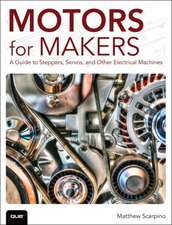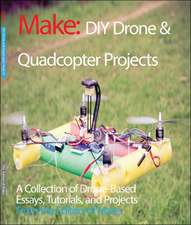New Trends in Medical and Service Robots: Challenges and Solutions: Mechanisms and Machine Science, cartea 20
Editat de Aleksandar Rodić, Doina Pisla, Hannes Bleuleren Limba Engleză Paperback – 3 sep 2016
| Toate formatele și edițiile | Preț | Express |
|---|---|---|
| Paperback (1) | 792.55 lei 39-44 zile | |
| Springer International Publishing – 3 sep 2016 | 792.55 lei 39-44 zile | |
| Hardback (1) | 957.32 lei 6-8 săpt. | |
| Springer International Publishing – 22 apr 2014 | 957.32 lei 6-8 săpt. |
Din seria Mechanisms and Machine Science
- 20%
 Preț: 817.43 lei
Preț: 817.43 lei - 17%
 Preț: 364.74 lei
Preț: 364.74 lei - 20%
 Preț: 1001.89 lei
Preț: 1001.89 lei - 18%
 Preț: 1268.55 lei
Preț: 1268.55 lei - 18%
 Preț: 945.79 lei
Preț: 945.79 lei - 18%
 Preț: 1275.65 lei
Preț: 1275.65 lei - 18%
 Preț: 1392.46 lei
Preț: 1392.46 lei - 18%
 Preț: 1386.17 lei
Preț: 1386.17 lei - 18%
 Preț: 2142.21 lei
Preț: 2142.21 lei - 18%
 Preț: 1382.21 lei
Preț: 1382.21 lei - 15%
 Preț: 604.87 lei
Preț: 604.87 lei - 18%
 Preț: 1104.43 lei
Preț: 1104.43 lei - 18%
 Preț: 2768.05 lei
Preț: 2768.05 lei - 18%
 Preț: 1625.27 lei
Preț: 1625.27 lei - 18%
 Preț: 1872.30 lei
Preț: 1872.30 lei - 18%
 Preț: 899.21 lei
Preț: 899.21 lei - 18%
 Preț: 1550.30 lei
Preț: 1550.30 lei - 18%
 Preț: 1832.85 lei
Preț: 1832.85 lei - 15%
 Preț: 649.87 lei
Preț: 649.87 lei - 18%
 Preț: 950.52 lei
Preț: 950.52 lei - 18%
 Preț: 953.97 lei
Preț: 953.97 lei - 18%
 Preț: 959.19 lei
Preț: 959.19 lei - 18%
 Preț: 1217.10 lei
Preț: 1217.10 lei - 18%
 Preț: 1387.73 lei
Preț: 1387.73 lei - 18%
 Preț: 1218.21 lei
Preț: 1218.21 lei - 18%
 Preț: 1546.05 lei
Preț: 1546.05 lei - 18%
 Preț: 1550.30 lei
Preț: 1550.30 lei - 18%
 Preț: 1846.73 lei
Preț: 1846.73 lei - 18%
 Preț: 1538.34 lei
Preț: 1538.34 lei - 18%
 Preț: 1000.24 lei
Preț: 1000.24 lei - 18%
 Preț: 1397.82 lei
Preț: 1397.82 lei -
 Preț: 448.88 lei
Preț: 448.88 lei - 18%
 Preț: 1233.52 lei
Preț: 1233.52 lei - 18%
 Preț: 1547.31 lei
Preț: 1547.31 lei
Preț: 792.55 lei
Preț vechi: 1042.83 lei
-24% Nou
Puncte Express: 1189
Preț estimativ în valută:
151.67€ • 158.15$ • 126.05£
151.67€ • 158.15$ • 126.05£
Carte tipărită la comandă
Livrare economică 17-22 martie
Preluare comenzi: 021 569.72.76
Specificații
ISBN-13: 9783319375823
ISBN-10: 3319375822
Pagini: 395
Ilustrații: XI, 384 p. 228 illus.
Dimensiuni: 155 x 235 x 21 mm
Greutate: 0.55 kg
Ediția:Softcover reprint of the original 1st ed. 2014
Editura: Springer International Publishing
Colecția Springer
Seria Mechanisms and Machine Science
Locul publicării:Cham, Switzerland
ISBN-10: 3319375822
Pagini: 395
Ilustrații: XI, 384 p. 228 illus.
Dimensiuni: 155 x 235 x 21 mm
Greutate: 0.55 kg
Ediția:Softcover reprint of the original 1st ed. 2014
Editura: Springer International Publishing
Colecția Springer
Seria Mechanisms and Machine Science
Locul publicării:Cham, Switzerland
Cuprins
Preface.- Robotic Assistance for Senior People for Safe Mobility and Work Support, by D. Eck, F. Leutert, K. Schilling.- The Robot that Learns from the Therapist how to Assist Stroke Patients, by M.D. Kostić, M.D. Popović, D.B. Popović.- Lower Limbs Robotic Rehabilitation: A case study with clinical trials, by M. Bouri, E. Abdi, H. Bleuler, F. Reynard and O. Deriaz.- Robot-Assisted 3D Medical Sonography, by P.B. Petrovic, N. Lukic and I. Danilov.- Innovative Approaches Regarding Robots for Brachytherapy, by D. Pisla, N. Plitea, B. Galdau, C. Vaida, B. Gherman.- Markerless Vision-Based Skeleton Tracking in Therapy of Gross Motor Skill Disorders in Children, by B. Karan, Š. Golubović, M. Gnjatović.- Force Training for Position/Force Control of Massage Robots, by V. Golovin, M. Arkhipov, V. Zhuravlev.- Flexible Bi-Modal Control Modes for Hands-Free Operation of a Wheelchair by Head Movements and Facial Expressions, by. E.J. Rechy-Ramirez and H. Hu.- New Results On Classifying EMG Signals for Interfacing Patients and Mechanical Devices, by G. Gini, L. Cavazzana, F. Mutti, P. Belluco, A. Mauri.- Mathematical Modelling of Human Affective Behavior Aimed to Development Robot EI-Controller, by A. Rodić, K. Addi.- Robot Skill Acquisition by Demonstration and Explorative Learning, by B. Nemec, A. Ude.- Two Faces of Human-Robot Interaction: Field and Service Robots, by R. Ventura.- Advanced Gesture and Pose Recognition Algorithms using Computational Intelligence and Microsoft KINECT Sensor, by D. Katić, P. Radulović, S. Spasojević ,Ž. Đurović, A. Rodić.- Recursive Design of Dependable Robot Systems for Safety-Critical Applications, by A. Wagner.- Some Applications of Biomimetics and Fractional Calculus in Control and Modeling of (Bio)robotic Systems M.Lazarević.- Towards Sensor-Less Haptic Teleoperation, by A. Hace, M. Franc.- Incorporation of Artificial Limbs and Role of Haptic Feedback, by A. Sengul, S. Shokur, H. Bleuler.- Offline Imitation of aHuman Motion by a Humanoid Robot Under Balance Constraint, by K. Munirathinam, C. Chevallereau, S. Sakka.- Contributions on the Modeling and Simulation of the Human Knee Joint with Applications to the Robotic Structures, by D. Tarnita, M. Catana, D.N. Tarnita.- How to Control Anthropomimetic Robot – Engineering and Cognitive Approach, by V. Potkonjak, K. Jovanovic and P. Milosavljevic.- Kinematic and Dynamic Modeling of a Parallel Manipulator with Eight Actuation Modes, by S. Caro, D. Chablat, P. Wenger and X. Kong.- Experiences on Service Robots at LARM in Cassino, by M. Ceccarelli, G. Carbone.- Moving from ‘How to Go There?’ to ‘Where to Go?’: Towards Increased Autonomy of Mobile Robots, by F. Amigoni, N. Basilico, A. Quattrini Li.- Safety for an Autonomous Bucket Excavator During Typical Landscaping Tasks, by G. Zolynski, D. Schmidt, and K. Berns.- Testing Capacity for Space Technology Suppliers, by A. Pisla, C.Vaida.
Textul de pe ultima copertă
This volume describes new frontiers in medical and service robotics in the light of recent developments in technology to advance robot design and implementation. In particular, the work looks at advances in design, development and implementation of contemporary surgical, rehabilitation and biorobots. Surgical robots allow surgeons greater access to areas under operation using more precise and less invasive methods. Rehabilitation robots facilitate and support the lives of the infirm, elderly people, or those with dysfunction of body parts affecting movement. These robots are also used for rehabilitation and related procedures, such as training and therapy. Biorobots are designed to imitate the cognition of humans and animals. The need to substitute humans working on delicate, tiresome and monotonous tasks, or working with potentially health-damaging toxic materials, requires intelligent, high-performance service robots with the ability to cooperate, advanced communication and sophisticated perception and cognitive capabilities. Progress in this field is fast and results need to be disseminated to stimulate both practical applications and further research. Thus, these papers are a valuable addition to existing literature.
Caracteristici
Presents a broad survey of contemporary technologies applied in medical and service robotics Presents new advanced methodologies applied in the fields of specific interests and points the way forward to new developments Original photos and technical performances of the robotic devices gathered together are made available to readers Includes supplementary material: sn.pub/extras











